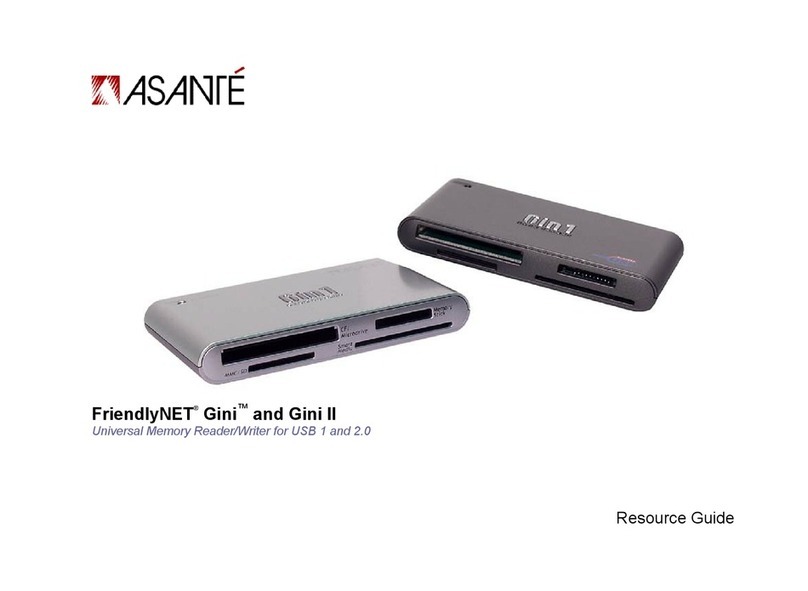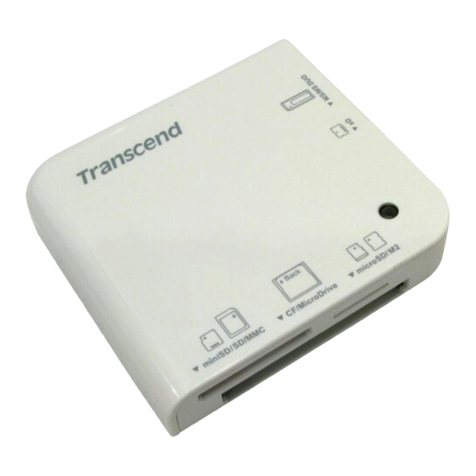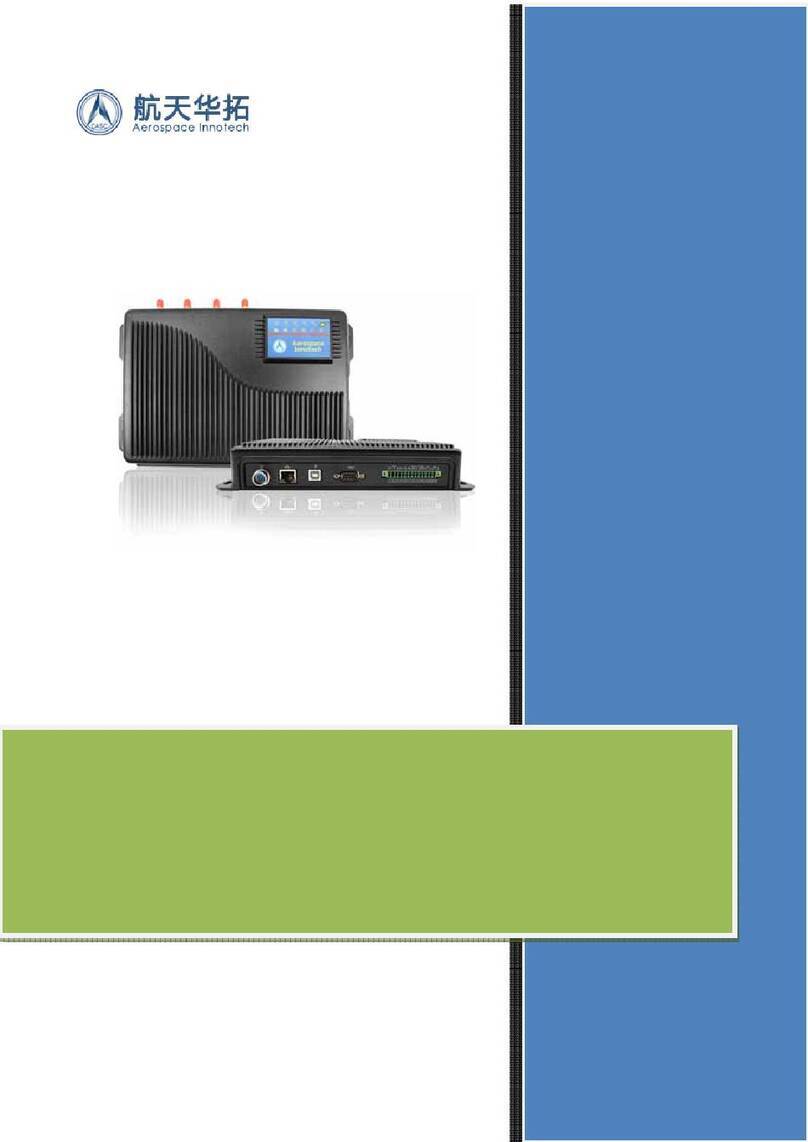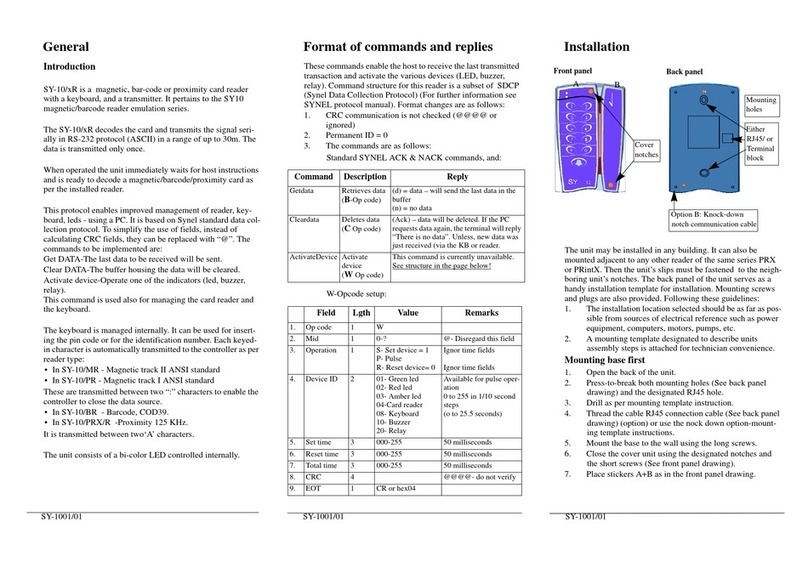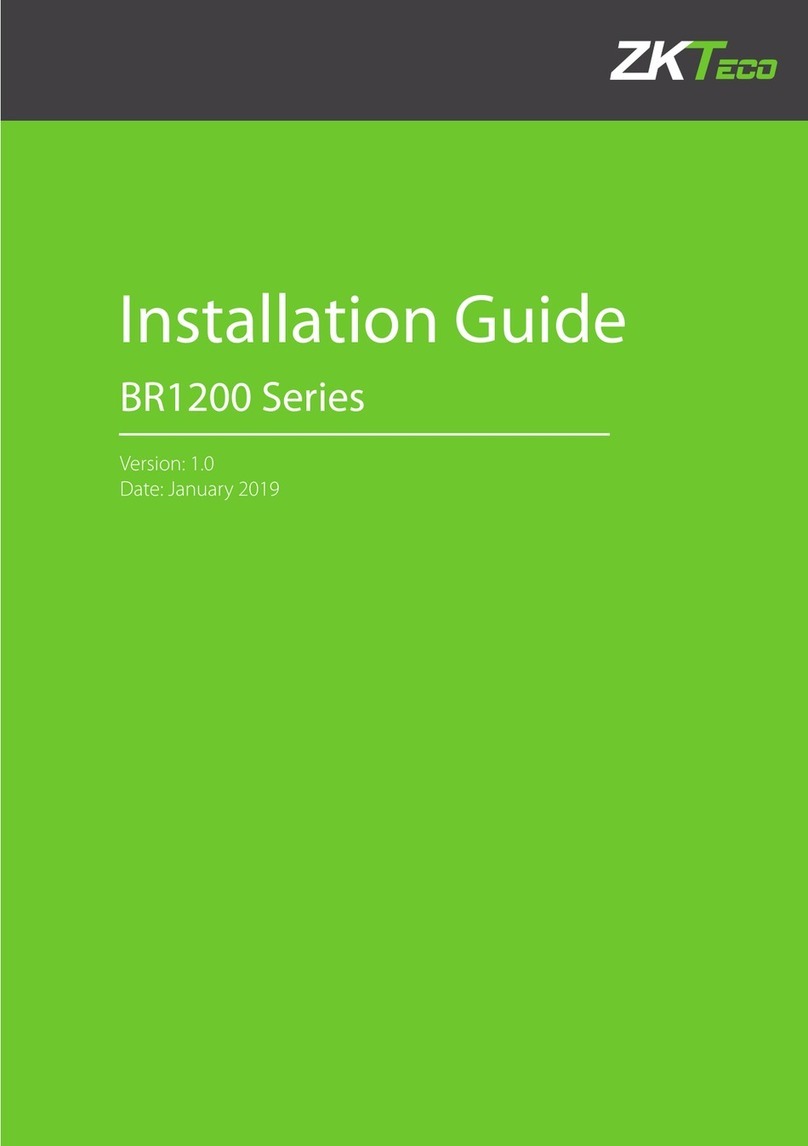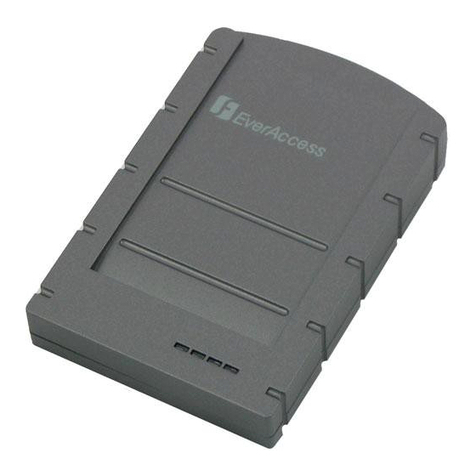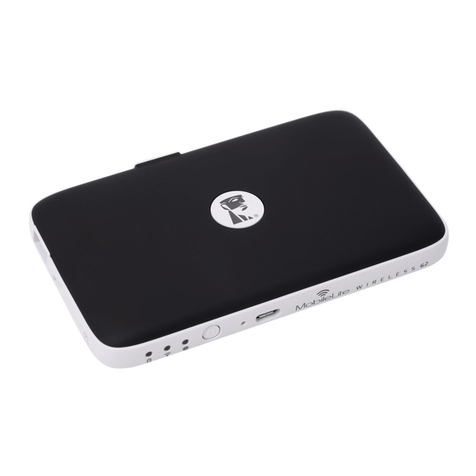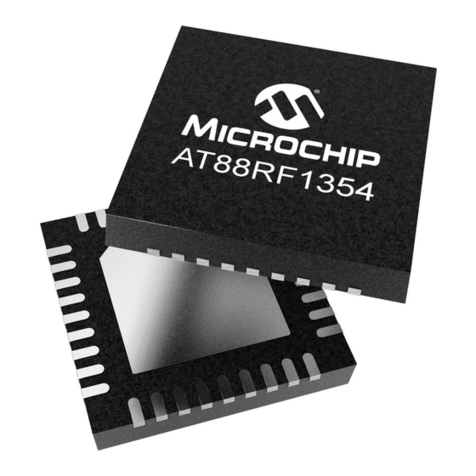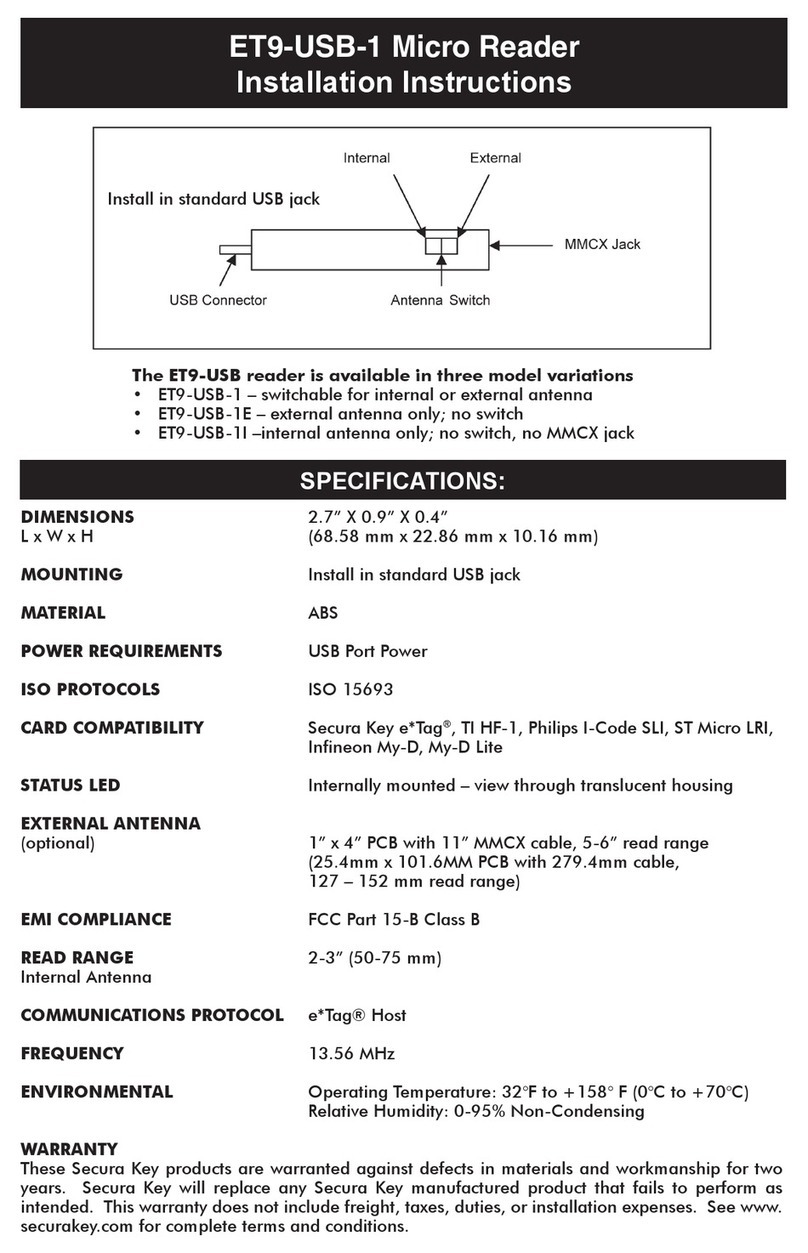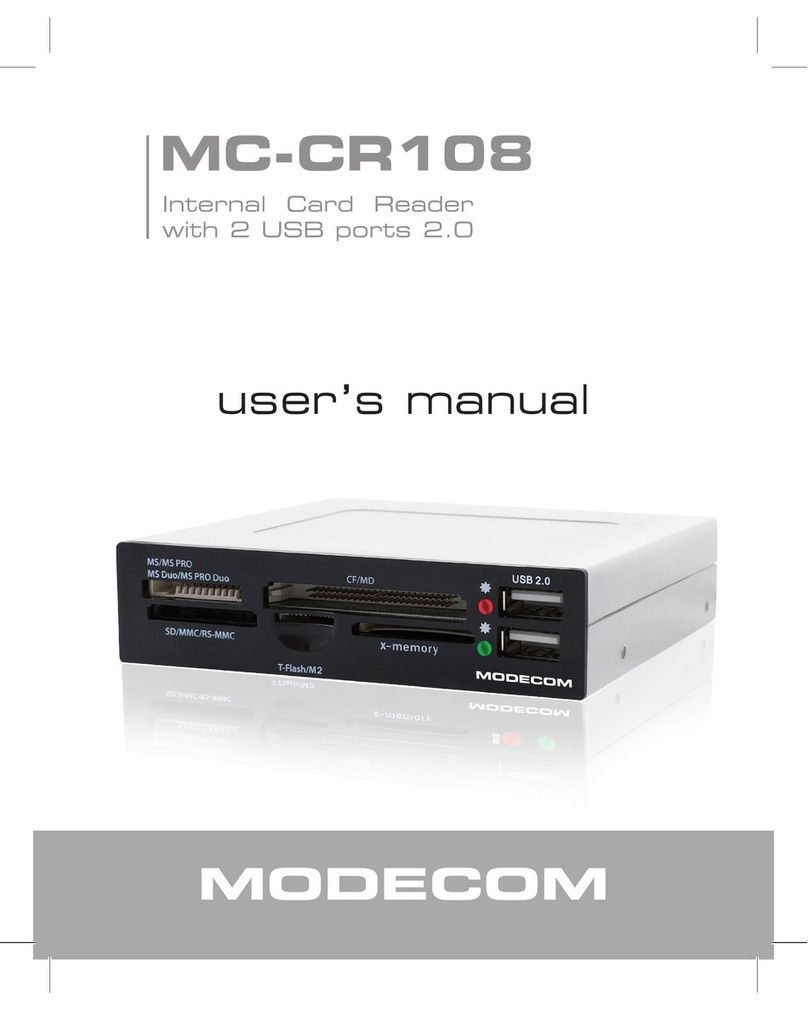Teridian 73S1209F User manual

73S1209F
Self-Contained PINpad, Smart Card Reade
r
IC UART to ISO7816 / EMV Bridge IC
Simplifying System Integration™ DATA SHEET
December 2008
Rev. 1.2 © 2008 Teridian Semiconductor Corporation 1
GENERAL DESCRIPTION
The Teridian Semiconductor Corporation 73S1209F is a
versatile and economical CMOS System-on-Chip device
intended for smart card reader applications. More
generally, it is suitable anywhere a UART to ISO-7816 /
EMV bridge function is needed. The circuit is built around
an 80515 high-performance core; it features primarily an
ISO-7816 / EMV interface and a generic asynchronous
serial interface. Delivered with turnkey Teridian embedded
firmware, it forms a ready-to-use smart card reader solution
that can be seamlessly incorporated into any
microprocessor-based system where a serial line is
available.
The solution is scalable, thanks to a built-in I2C interface
that allows to drive external electrical smart card interfaces
such as Teridian 73S8010R/C ICs. This makes the solution
immediately able to support multi-card slots or multi-SAM
architectures.
In addition, the 73S1209F features a 5x6 PINpad interface,
9 user I/Os, 2 LED outputs (programmable current),
multiple interrupt options and an analog voltage input (for
DC voltage monitoring such as battery level detection) that
make it suitable for low-cost PINpad reader devices.
The 80515 CPU core instruction set is compatible with the
industry standard 8051, while offering one clock-cycle per
instruction processing power (most instructions). With a
CPU clock running up to 24MHz, it results in up to 24MIPS
available that meets the requirements of various encryption
needs such as AES, DES / 3-DES and even RSA (for PIN
encryption for instance).
The circuit requires a single 6MHz to 12MHz crystal.
The respective 73S1209F embedded memories are 32KB
Flash program memory, 2KB user XRAM memory, and
256B IRAM memory. Dedicated FIFOs for the ISO7816
UART are independent from the user XRAM and IRAM.
Alternatively to the turnkey firmware offered by Teridian,
customers can develop their own embedded firmware
directly within their application or using Teridian 73S1209F
Evaluation Board through a JTAG-like interface.
Overall, the Teridian 73S1209F IC requires 2 distinct power
supply voltages to operate normally with full support of all
smart card voltages, 1.8V, 3V and 5V. The digital power
supply VDD requires a 2.7V to 3.6V voltage, and the analog
power supply VPC requires typically a 4.75V to 6.0V.
While the VDD is used to power up the CPU core and the
digital functions of the IC, the VPC voltage is used to supply
the proper VCC voltage to the smart card interface: The chip
incorporates an low drop-out linear voltage regulator that
generates the smart card power-supply VCC from the power
supply source VPC.
Embedded Flash memory is in-system programmable
and lockable by means of on-silicon fuses. This makes
the 73S1209F suitable for both development and
production phases.
Teridian Semiconductor Corporation offers with its
73S1209F a very comprehensive set of software
libraries for EMV. Refer to the 73S12xxF Software
User’s Guide for a complete description of the
Application Programming Interface (API Libraries) and
related Software modules.
A complete array of development and programming
tools, libraries and demonstration boards enable rapid
development and certification of readers that meet
most demanding smart card standards.
APPLICATIONS
•UART to ISO-7816 / EMV Bridges
•PINpad smart card readers:
oWith serial connectivity
oIdeal for low-cost POS Terminals) & Digital
Identification (Secure Login, Gov’t ID...)
•SIM Readers in Telecom & Personal Wireless
devices
•Payphones and vending machines
•General purpose smart card readers
ADVANTAGES
•Reduced BOM
•Low-Cost
•Dual power supply required 3.3V and 5V
typical
•Higher performance CPU core (up to 24MIPS)
•Built-in EMV/ISO slot, expandable to multi-
slots
•Powerful In-Circuit Emulation and
Programming
•A complete set of EMV4.1 / ISO-7816
libraries
•Turnkey PC/SC and CCID firmware and host
drivers
oSupported OS: Windows XP, WindowsTM
Mobile; Windows CE; Linux
oOther OS: Contact Teridian Semiconductor

73S1209F Data Sheet DS_1209F_004
2 Rev. 1.2
FEATURES
80515 Core:
•1 clock cycle per instruction (most instructions)
•CPU clocked up to 24MHz
•32kB Flash memory with security
•2kB XRAM (User Data Memory)
•256 byte IRAM
•Hardware watchdog timer
Oscillators:
•Single low-cost 6MHz to 12MHz crystal
•An Internal PLL provides all the necessary clocks
to each block of the system
Interrupts:
•Standard 80C515 4-priority level structure
•9 different sources of interrupt to the core
Power Down Modes:
•2 standard 80C515 Power Down and IDLE
modes
•Extensive device power down mode
Timers:
•(2) Standard 80C52 timers T0 and T1
•(1) 16-bit timer
Built-in ISO-7816 Card Interface:
•Linear regulator produces VCC for the card
(1.8V, 3V or 5V)
•Full compliance with EMV 4.1
•Activation/Deactivation sequencers
•Auxiliary I/O lines (C4 and C8 signals)
•7kV ESD protection on all interface pins
Communication with Smart Cards:
•ISO-7816 UART for protocols T=0, T=1
•(2) 2-Byte FIFOs for transmit and receive
•Configured to drive multiple external Teridian
73S8010x interfaces (for multi-SAM
architectures)
Communication Interfaces:
•Full-duplex serial interface (1200bps to
115kbps UART)
•I
2C Master Interface (400kbps)
Man-Machine Interface and I/Os:
•5x6 Keyboard (hardware scanning,
debouncing and scrambling)
•(9) User I/Os
•Up to 2 programmable current outputs (LED)
Voltage Detection:
•Analog Input (detection range: 1.0V to 2.5V)
•Operating Voltage:
•2.7V to 3.6V Digital power supply
•4.75 to 5.5V Analog, smart card power
supply
Operating Temperature:
•-40°C to 85°C
Package:
•68-pin QFN, 44-pin QFN
Software:
•Turnkey firmware:
oCompliant with PC/SC, CCID, ISO7816
and EMV4.1 specifications
oFeatures a Power Down mode accessible
form the host
oSupports Plug & Play over serial interface
oWindows® XP driver available (*)
oWindows CE / Mobile driver available (*)
oLinux and other OS: Upon request
•Or for custom developments:
oA complete set of ISO-7816, EMV4.1 and
low-level libraries are available for T=0 /
T=1
oTwo-level Application Programming
Interface (ANSI C-language libraries)
(*) Contact Teridian Semiconductor for
conditions and availability

DS_1209F_004 73S1209F Data Sheet
Rev. 1.2 3
Table of Contents
1Hardware Description......................................................................................................................... 8
1.1Pin Description.............................................................................................................................. 8
1.2Hardware Overview .................................................................................................................... 11
1.380515 MPU Core ........................................................................................................................ 11
1.3.180515 Overview............................................................................................................. 11
1.3.2Memory Organization .................................................................................................... 11
1.4Program Security ........................................................................................................................ 16
1.5Special Function Registers (SFRs) ............................................................................................ 18
1.5.1Internal Data Special Function Registers (SFRs).......................................................... 18
1.5.2IRAM Special Function Registers (Generic 80515 SFRs) ............................................ 19
1.5.3External Data Special Function Registers (SFRs) ........................................................ 21
1.6Instruction Set............................................................................................................................. 23
1.7Peripheral Descriptions............................................................................................................... 23
1.7.1Oscillator and Clock Generation.................................................................................... 23
1.7.2Power Control Modes .................................................................................................... 27
1.7.3Interrupts........................................................................................................................ 32
1.7.4UART .............................................................................................................................39
1.7.5Timers and Counters ..................................................................................................... 44
1.7.6WD Timer (Software Watchdog Timer) ......................................................................... 46
1.7.7User (USR) Ports........................................................................................................... 49
1.7.8Analog Voltage Comparator .......................................................................................... 51
1.7.9LED Drivers ................................................................................................................... 53
1.7.10I2C Master Interface....................................................................................................... 54
1.7.11Keypad Interface............................................................................................................ 61
1.7.12Emulator Port................................................................................................................. 67
1.7.13Smart Card Interface Function ...................................................................................... 68
1.7.14VDD Fault Detect Function.......................................................................................... 102
2Typical Application Schematics.................................................................................................... 103
3Electrical Specification................................................................................................................... 105
3.1Absolute Maximum Ratings ...................................................................................................... 105
3.2Recommended Operating Conditions ...................................................................................... 105
3.3Digital IO Characteristics .......................................................................................................... 106
3.4Oscillator Interface Requirements ............................................................................................ 106
3.5DC Characteristics: Analog Input ............................................................................................. 106
3.6Smart Card Interface Requirements......................................................................................... 107
3.7DC Characteristics.................................................................................................................... 109
3.8Voltage / Temperature Fault Detection Circuits ....................................................................... 109
4Equivalent Circuits ......................................................................................................................... 110
4.1Package Pin Designation (68-pin QFN) ................................................................................... 117
4.2Package Pin Designation (44-pin QFN) ................................................................................... 118
4.3Packaging Information .............................................................................................................. 119
5Ordering Information ...................................................................................................................... 121
6Related Documentation.................................................................................................................. 121
7Contact Information........................................................................................................................ 121
Revision History...................................................................................................................................... 122

73S1209F Data Sheet DS_1209F_004
Figures
Figure 1: IC Functional Block Diagram ......................................................................................................... 7
Figure 2: Memory Map ................................................................................................................................ 15
Figure 3: Clock Generation and Control Circuits ........................................................................................ 24
Figure 4: Oscillator Circuit........................................................................................................................... 26
Figure 5: Power-Down Control.................................................................................................................... 27
Figure 6: Detail of Power-Down Interrupt Logic.......................................................................................... 28
Figure 7: Power-Down Sequencing ............................................................................................................ 28
Figure 8: External Interrupt Configuration................................................................................................... 32
Figure 9: I2C Write Mode Operation........................................................................................................... 55
Figure 10: I2C Read Operation.................................................................................................................... 56
Figure 11: Simplified Keypad Block Diagram.............................................................................................. 61
Figure 12: Keypad Interface Flow Chart ..................................................................................................... 63
Figure 13: Smart Card Interface Block Diagram......................................................................................... 68
Figure 14: External Smart Card Interface Block Diagram........................................................................... 69
Figure 15: Asynchronous Activation Sequence Timing .............................................................................. 72
Figure 16: Deactivation Sequence.............................................................................................................. 72
Figure 17: Smart Card CLK and ETU Generation ...................................................................................... 73
Figure 18: Guard, Block, Wait and ATR Time Definitions........................................................................... 74
Figure 19: Synchronous Activation ............................................................................................................. 76
Figure 20: Example of Sync Mode Operation: Generating/Reading ATR Signals ..................................... 76
Figure 21: Creation of Synchronous Clock Start/Stop Mode Start Bit in Sync Mode ................................. 77
Figure 22: Creation of Synchronous Clock Start/Stop Mode Stop Bit in Sync Mode ................................. 77
Figure 23: Operation of 9-bit Mode in Sync Mode ...................................................................................... 78
Figure 24: 73S1209F Typical PINpad, Smart Card Reader Application Schematic................................. 103
Figure 25: 73S1209F Typical SIM / Smart Card Reader Application Schematic ..................................... 104
Figure 26: 12 MHz Oscillator Circuit ......................................................................................................... 110
Figure 27: Digital I/O Circuit ...................................................................................................................... 110
Figure 28: Digital Output Circuit ................................................................................................................ 111
Figure 29: Digital I/O with Pull Up Circuit.................................................................................................. 111
Figure 30: Digital I/O with Pull Down Circuit ............................................................................................. 112
Figure 31: Digital Input Circuit................................................................................................................... 112
Figure 32: Keypad Row Circuit ................................................................................................................. 113
Figure 33: Keypad Column Circuit ............................................................................................................ 113
Figure 34: LED Circuit............................................................................................................................... 114
Figure 35: Test and Security Pin Circuit ................................................................................................... 114
Figure 36: Analog Input Circuit.................................................................................................................. 115
Figure 37: Smart Card Output Circuit ....................................................................................................... 115
Figure 38: Smart Card I/O Circuit.............................................................................................................. 116
Figure 39: PRES Input Circuit ................................................................................................................... 116
Figure 40: PRES Input Circuit ................................................................................................................... 116
Figure 41: 73S1209F Pinout ..................................................................................................................... 117
Figure 42: 73S1209F Pinout ..................................................................................................................... 118
Figure 43: 73S1209F 68 QFN Pinout ....................................................................................................... 119
Figure 44: 73S1209F 44 QFN Pinout ....................................................................................................... 120
4 Rev. 1.2

DS_1209F_004 73S1209F Data Sheet
Rev. 1.2 5
Tables
Table 1: 73S1209F Pinout Description ......................................................................................................... 8
Table 2: MPU Data Memory Map................................................................................................................ 11
Table 3: Flash Special Function Registers ................................................................................................. 13
Table 4: Internal Data Memory Map ........................................................................................................... 14
Table 5: Security Control Registers ............................................................................................................ 17
Table 6: IRAM Special Function Registers Locations................................................................................. 18
Table 7: IRAM Special Function Registers Reset Values........................................................................... 19
Table 8: XRAM Special Function Registers Reset Values ......................................................................... 21
Table 9: PSW Register Flags...................................................................................................................... 22
Table 10: Port Registers ............................................................................................................................. 23
Table 11: Frequencies and Mcount Values for MCLK = 96MHz ................................................................ 25
Table 12: The MCLKCtl Register ................................................................................................................ 25
Table 13: The MPUCKCtl Register ............................................................................................................. 26
Table 14: The INT5Ctl Register .................................................................................................................. 29
Table 15: The MISCtl0 Register.................................................................................................................. 29
Table 16: The MISCtl1 Register.................................................................................................................. 30
Table 17: The MCLKCtl Register ................................................................................................................ 30
Table 18: The PCON Register .................................................................................................................... 31
Table 19: The IEN0 Register....................................................................................................................... 33
Table 20: The IEN1 Register....................................................................................................................... 34
Table 21: The IEN2 Register....................................................................................................................... 34
Table 22: The TCON Register .................................................................................................................... 35
Table 23: The T2CON Register .................................................................................................................. 35
Table 24: The IRCON Register................................................................................................................... 36
Table 25: External MPU Interrupts.............................................................................................................. 36
Table 26: Control Bits for External Interrupts.............................................................................................. 37
Table 27: Priority Level Groups................................................................................................................... 37
Table 28: The IP0 Register ......................................................................................................................... 37
Table 29: The IP1 Register ......................................................................................................................... 38
Table 30: Priority Levels.............................................................................................................................. 38
Table 31: Interrupt Polling Sequence.......................................................................................................... 38
Table 32: Interrupt Vectors.......................................................................................................................... 38
Table 33: UART Modes............................................................................................................................... 39
Table 34: Baud Rate Generation ................................................................................................................ 39
Table 35: The PCON Register .................................................................................................................... 40
Table 36: The BRCON Register ................................................................................................................. 40
Table 37: The MISCtl0 Register.................................................................................................................. 41
Table 38: The S0CON Register .................................................................................................................. 42
Table 39: The S1CON Register .................................................................................................................. 43
Table 40: The TMOD Register .................................................................................................................... 44
Table 41: TMOD Register Bit Description................................................................................................... 44
Table 42: Timers/Counters Mode Description ............................................................................................ 45
Table 43: The TCON Register .................................................................................................................... 46
Table 44: The IEN0 Register....................................................................................................................... 47
Table 45: The IEN1 Register....................................................................................................................... 47
Table 46: The IP0 Register ......................................................................................................................... 48
Table 47: The WDTREL Register ............................................................................................................... 48
Table 48: Direction Registers and Internal Resources for DIO Pin Groups ............................................... 49
Table 49: UDIR Control Bit.......................................................................................................................... 49
Table 50: Selectable Controls Using the UxIS Bits..................................................................................... 49
Table 51: The USRIntCtl1 Register ............................................................................................................ 50
Table 52: The USRIntCtl2 Register ............................................................................................................ 50
Table 53: The USRIntCtl3 Register ............................................................................................................ 50
Table 54: The USRIntCtl4 Register ............................................................................................................ 50
Table 55: The ACOMP Register ................................................................................................................. 51
Table 56: The INT6Ctl Register .................................................................................................................. 52

73S1209F Data Sheet DS_1209F_004
Table 57: The LEDCtl Register ................................................................................................................... 53
Table 58: The DAR Register ....................................................................................................................... 57
Table 59: The WDR Register...................................................................................................................... 57
Table 60: The SWDR Register.................................................................................................................... 58
Table 61: The RDR Register....................................................................................................................... 58
Table 62: The SRDR Register .................................................................................................................... 59
Table 63: The CSR Register ....................................................................................................................... 59
Table 64: The INT6Ctl Register .................................................................................................................. 60
Table 65: The KCOL Register..................................................................................................................... 64
Table 66: The KROW Register ................................................................................................................... 64
Table 67: The KSCAN Register .................................................................................................................. 65
Table 68: The KSTAT Register ................................................................................................................... 65
Table 69: The KSIZE Register .................................................................................................................... 66
Table 70: The KORDERL Register ............................................................................................................. 66
Table 71: The KORDERH Register ............................................................................................................ 67
Table 72: The INT5Ctl Register .................................................................................................................. 67
Table 73: The SCSel Register .................................................................................................................... 79
Table 74: The SCInt Register...................................................................................................................... 80
Table 75: The SCIE Register ...................................................................................................................... 81
Table 76: The VccCtl Register .................................................................................................................... 82
Table 77: The VccTmr Register .................................................................................................................. 83
Table 78: The CRDCtl Register .................................................................................................................. 84
Table 79: The STXCtl Register ................................................................................................................... 85
Table 80: The STXData Register................................................................................................................ 86
Table 81: The SRXCtl Register................................................................................................................... 86
Table 82: The SRXData Register ............................................................................................................... 87
Table 83: The SCCtl Register ..................................................................................................................... 88
Table 84: The SCECtl Register................................................................................................................... 89
Table 85: The SCDIR Register ................................................................................................................... 90
Table 86: The SPrtcol Register ................................................................................................................... 91
Table 87: The SCCLK Register................................................................................................................... 92
Table 88: The SCECLK Register ................................................................................................................ 92
Table 89: The SParCtl Register .................................................................................................................. 93
Table 90: The SByteCtl Register................................................................................................................. 94
Table 91: The FDReg Register ................................................................................................................... 95
Table 92: Divider Ratios Provided by the ETU Counter ............................................................................. 95
Table 93: Divider Values for the ETU Clock ............................................................................................... 96
Table 94: The CRCMsB Register ............................................................................................................... 97
Table 95: The CRCLsB Register ................................................................................................................ 97
Table 96: The BGT Register ....................................................................................................................... 98
Table 97: The EGT Register ....................................................................................................................... 98
Table 98: The BWTB0 Register .................................................................................................................. 99
Table 99: The BWTB1 Register .................................................................................................................. 99
Table 100: The BWTB2 Register ................................................................................................................ 99
Table 101: The BWTB3 Register ................................................................................................................ 99
Table 102: The CWTB0 Register................................................................................................................ 99
Table 103: The CWTB1 Register................................................................................................................ 99
Table 104: The ATRLsB Register ............................................................................................................. 100
Table 105: The ATRMsB Register ............................................................................................................ 100
Table 106: The STSTO Register............................................................................................................... 100
Table 107: The RLength Register............................................................................................................. 100
Table 108: Smart Card SFR Table ........................................................................................................... 101
Table 109: The VDDFCtl Register ............................................................................................................ 102
Table 110: Order Numbers and Packaging Marks ................................................................................... 121
6 Rev. 1.2

DS_1209F_004 73S1209F Data Sheet
Rev. 1.2 7
SMART
CARD
ISO
INTERFACE
SCLK
SIO
EXTERNAL
SMART
CARD
INTERFACE
VCC
CONTROL
LOGIC
LED
DRIVERS
GND
TBUS1
TBUS2
TBUS3
TBUS0
RXTX
ERST
ISBR
TCLK
TXD
RXD
LED1
LED0
ICE INTERFACE
SEC
SMART CARD LOGIC
ISO UART and CLOCK GENERATOR
FLASH/ROM
PROGRAM
MEMORY
32KB
DATA
XRAM
2KB
CORE
SERIAL
VDD
INT2
INT3
GND
GND
PERIPHERAL
INTERFACE
and SFR LOGIC
FLASH
INTERFACE
TEST
OCDSI
ISR
WATCH-
DOG
TIMER
PMU
PORTS
TIMER_0_
1
MEMORY_
CONTROL
CONTROL
UNIT
RAM_
SFR_
CONTROL
ALU
RESET
VOLTAGE REFERENCE
AND FUSE TRIM
CIRCUITRY
VPD REGULATOR
ANA_IN
PLL
and
TIMEBASES
VDD
SCRATCH
IRAM
256B
12MHz
OSCILLATOR
X12OUT
X12IN
COL4
COL3
COL2
COL1
COL0
ROW5
ROW4
ROW3
ROW2
ROW1
ROW0
KEYPAD
INTERFACE
I2C
MASTER
INT.
SDA
SCL
USR(8:0)
DRIVERS
USR7
USR6
USR5
USR4
USR3
USR1
USR2
USR0
USR8
VCC
RST
CLK
I/O
AUX2
AUX1
PRES
PRESB
VPC
Pins avaiable on both 68 and 44 pin packages.
Pins only avaiable on 68 pin package.
GND
VDD
Figure 1: IC Functional Block Diagram

73S1209F Data Sheet DS_1209F_004
1 Hardware Description
1.1 Pin Description
Table 1: 73S1209F Pinout Description
Pin Name
Pin (68 QFN)
Pin (44 QFN)
Type
Equivalent
Circuit*
Description
X12IN 10 8 I
Figure 26 MPU clock crystal oscillator input pin. A 1MΩresistor is
required between pins X12IN and X12OUT.
X12OUT 11 9 O Figure 26 MPU clock crystal oscillator output pin.
ROW (5:0)
0
1
2
3
4
5
21
22
24
34
37
38
I
Figure 32 Keypad row input sense.
COL(4:0)
0
1
2
3
4
12
13
14
16
19
O Figure 33 Keypad column output scan pins.
USR(8:0)
0
1
2
3
4
5
6
7
8
36
35
33
31
30
29
23
20
32
24
23
22
21
20
19
14
13
IO Figure 29 General-purpose user pins, individually configurable as
inputs or outputs or as external input interrupt ports.
SCL 5 5 O Figure 28 I2C (master mode) compatible Clock signal. Note: the
pin is configured as an open drain output. When the
I2C interface is being used, an external pull up resistor
is required. A value of 3K is recommended.
SDA 6 6 IO Figure 27 I2C (master mode) compatible data I/O. Note: this pin is
bi-directional. When the pin is configured as output, it is
an open drain output. When the I2C interface is being
used, an external pull up resistor is required. A value of
3K is recommended.
LED(1:0)
0
1
1
3
3
4
IO
Figure 34 Special output drivers, programmable pull-down current
to drive LEDs. May also be used as inputs.
RXD 17 11 I Figure 31 Serial UART Receive data pin.
TXD 18 12 O Figure 28 Serial UART Transmit data pin.
INT3 51 I Figure 31 General purpose interrupt input.
8 Rev. 1.2

DS_1209F_004 73S1209F Data Sheet
Rev. 1.2 9
Pin Name
Pin (68 QFN)
Pin (44 QFN)
Type
Equivalent
Circuit*
Description
INT2 52 32 I Figure 31 General purpose interrupt input.
SIO 50 31 IO Figure 27 IO data signal for use with external Smart Card interface
circuit such as 73S8010.
SCLK 48 30 O Figure 28 Clock signal for use with external Smart Card interface
circuit.
PRES 64 43 I Figure 39 Smart Card presence. Active high. Note: the pin has a
very weak pull down resistor. In noisy environments, an
external pull down may be desired to insure against a
false card event.
PRESB 56 35 I Figure 40 Smart Card presence. Active low. Note: the pin has a
very weak pull up resistor. In noisy environments, an
external pull up may be desired to insure against a false
card event.
CLK 57 36 O Figure 37 Smart card clock signal.
RST 59 38 O Figure 37 Smart card Reset signal.
IO 63 42 IO Figure 38 Smart card Data IO signal.
AUX1 62 41 IO Figure 38 Auxiliary Smart Card IO signal (C4).
AUX2 61 40 IO Figure 38 Auxiliary Smart Card IO signal (C8).
VCC 60 39 PSO Smart Card VCC supply voltage output. A 0.47μF
capacitor is required and should be located at the smart
card connector. The capacitor should be a ceramic type
with low ESR.
GND 58 37 GND Smart Card Ground.
VPC 55 34 PSI Smart Card LDO regulator power supply source. A
10μF and a 0.1μF capacitor are required at the VPC
input. The 10μF capacitor should be a ceramic type
with low ESR.
TBUS(3:0)
0
1
2
3
53
49
47
43
IO
Trace bus signals for ICE.
RXTX 45 28 IO ICE control.
ERST 40 25 IO ICE control.
ISBR 68 IO ICE control.
TCLK 41 26 I ICE control.
ANA_IN 15 10 AI
Figure 36 Analog input pin. This signal goes to a programmable
comparator and is used to sense the value of an
external voltage.
SEC 67 2 I Figure 35 Input pin for use in programming security fuse. It should
be connected to ground when not in use.
TEST 54 33 DI Figure 35 Test pin, should be connected to ground.

73S1209F Data Sheet DS_1209F_004
Pin Name
Pin (68 QFN)
Pin (44 QFN)
Type
Equivalent
Circuit*
Description
VDD 28
42
65
18
27
44
I General positive power supply pins. All digital IO is
referred to this supply voltage. There is an on-chip
regulator that uses VDD to provide power for internal
circuits (VPD). A 0.1μF capacitor is recommended at
each VDD pin.
N/C 2
4
7
8
26
27
39
46
16
17
29
No connect.
GND 9
25
44
7
15
GND
General ground supply pins for all IO and logic circuits.
RESET 66 1 I Figure 31 Reset input, positive assertion. Resets logic and
registers to default condition.
* See the figures in the Equivalent Circuits section.
10 Rev. 1.2

DS_1209F_004 73S1209F Data Sheet
Rev. 1.2 11
1.2 Hardware Overview
The 73S1209F single smart card controller integrates all primary functional blocks required to implement
a smart card reader. Included on chip are an 8051-compatible microprocessor (MPU) which executes up
to one instruction per clock cycle (80515), a fully integrated IS0-7816 compliant smart card interface,
expansion smart card interface, serial interface, I2C interface, 6 x 5 keypad interface, 2 LED drivers,
RAM, FLASH memory, and a variety of I/O pins. A functional block diagram of the 73S1209F is shown in
Figure 1.
1.3 80515 MPU Core
1.3.1 80515 Overview
The 73S1209F includes an 80515 MPU (8-bit, 8051-compatible) that performs most instructions in one
clock cycle. The 80515 architecture eliminates redundant bus states and implements parallel execution
of fetch and execution phases. Normally a machine cycle is aligned with a memory fetch, therefore, most
of the 1-byte instructions are performed in a single cycle. This leads to an 8x performance (average)
improvement (in terms of MIPS) over the Intel 8051 device running at the same clock frequency.
Actual processor clocking speed can be adjusted to the total processing demand of the application
(cryptographic calculations, key management, memory management, and I/O management) using the
XRAM special function register MPUCKCtl.
Typical smart card, serial, keyboard and I2C management functions are available for the MPU as part of
Teridian’s standard library. A standard ANSI “C” 80515-application programming interface library is
available to help reduce design cycle. Refer to the 73S12xxF Software User’s Guide.
1.3.2 Memory Organization
The 80515 MPU core incorporates the Harvard architecture with separate code and data spaces.
Memory organization in the 80515 is similar to that of the industry standard 8051. There are three
memory areas: Program memory (Flash), external data memory (XRAM), and internal data memory
(IRAM). Data bus address space is allocated to on-chip memory as shown Table 2
Table 2: MPU Data Memory Map
Address
(hex)
Memory
Technology Memory Type Typical Usage Memory Size
(bytes)
0000-7FFF Flash Memory Non-volatile Program and non-volatile data 32KB
0000-07FF Static RAM Volatile MPU data XRAM 2KB
FC00-FFFF External SFR Volatile Peripheral control 1KB
Note: The IRAM is part of the core and is addressed differently.
Program Memory: The 80515 can address up to 32KB of program memory space from 0x0000 to
0x7FFF. Program memory is read when the MPU fetches instructions or performs a MOVC operation.
After reset, the MPU starts program execution from location 0x0000. The lower part of the program
memory includes reset and interrupt vectors. The interrupt vectors are spaced at 8-byte intervals, starting
from 0x0003. Reset is located at 0x0000.
Flash Memory: The program memory consists of flash memory. The flash memory is intended to
primarily contain MPU program code. Flash erasure is initiated by writing a specific data pattern to
specific SFR registers in the proper sequence. These special pattern/sequence requirements prevent
inadvertent erasure of the flash memory.

73S1209F Data Sheet DS_1209F_004
The mass erase sequence is:
1. Write 1 to the FLSH_MEEN bit in the FLSHCTL register (SFR address 0xB2[1]).
2. Write pattern 0xAA to ERASE (SFR address 0x94).
Note: The mass erase cycle can only be initiated when the ICE port is enabled.
The page erase sequence is:
1. Write the page address to PGADDR (SFR address 0xB7[7:1])
2. Write pattern 0x55 to ERASE (SFR address 0x94)
The PGADDR register denotes the page address for page erase. The page size is 512 (200h) bytes and
there are 128 pages within the flash memory. The PGADDR denotes the upper seven bits of the flash
memory address such that bit 7:1 of the PGADDR corresponds to bit 15:9 of the flash memory address.
Bit 0 of the PGADDR is not used and is ignored. The MPU may write to the flash memory. This is one of
the non-volatile storage options available to the user. The FLSHCTL SFR bit FLSH_PWE (flash program
write enable) differentiates 80515 data store instructions (MOVX@DPTR,A) between Flash and XRAM
writes. Before setting FLSH_PWE, all interrupts need to be disabled by setting EAL = 1. Table 3 shows
the location and description of the 73S1209F flash-specific SFRs.
Any flash modifications must set the CPUCLK to operate at 3.6923 MHz (MPUCLKCtl = 0x0C)
before any flash memory operations are executed to insure the proper timing when modifying the
flash memory.
12 Rev. 1.2

DS_1209F_004 73S1209F Data Sheet
Rev. 1.2 13
Table 3: Flash Special Function Registers
Register SFR
Address
R/W Description
ERASE 0x94 W This register is used to initiate either the Flash Mass Erase cycle or the
Flash Page Erase cycle. Specific patterns are expected for ERASE in
order to initiate the appropriate Erase cycle (default = 0x00).
0x55 – Initiate Flash Page Erase cycle. Must be proceeded by a write to
PGADDR @ SFR 0xB7.
0xAA – Initiate Flash Mass Erase cycle. Must be proceeded by a write
to FLSH_MEEN @ SFR 0xB2 and the debug port must be enabled.
Any other pattern written to ERASE will have no effect.
PGADDR 0xB7 R/W Flash Page Erase Address register containing the flash memory page
address (page 0 through 127) that will be erased during the Page Erase
cycle (default = 0x00). Note: the page address is shifted left by one bit
(see detailed description above).
Must be re-written for each new Page Erase cycle.
FLSHCTL 0xB2 R/W
Bit 0 (FLSH_PWE): Program Write Enable:
0 – MOVX commands refer to XRAM Space, normal operation (default).
1 – MOVX @DPTR,A moves A to Program Space (Flash) @ DPTR.
This bit is automatically reset after each byte written to flash. Writes to
this bit are inhibited when interrupts are enabled.
W Bit 1 (FLSH_MEEN): Mass Erase Enable:
0 – Mass Erase disabled (default).
1 – Mass Erase enabled.
Must be re-written for each new Mass Erase cycle.
R/W Bit 6 (SECURE):
Enables security provisions that prevent external reading of flash
memory and CE program RAM. This bit is reset on chip reset and may
only be set. Attempts to write zero are ignored.

73S1209F Data Sheet DS_1209F_004
Internal Data Memory: The Internal data memory provides 256 bytes (0x00 to 0xFF) of data memory.
The internal data memory address is always one byte wide and can be accessed by either direct or
indirect addressing. The Special Function Registers occupy the upper 128 bytes. This SFR area is
available only by direct addressing. Indirect addressing accesses the upper 128 bytes of Internal
RAM.
The lower 128 bytes contain working registers and bit-addressable memory. The lower 32 bytes form
four banks of eight registers (R0-R7). Two bits on the program memory status word (PSW) select which
bank is in use. The next 16 bytes form a block of bit-addressable memory space at bit addressees 0x00-
0x7F. All of the bytes in the lower 128 bytes are accessible through direct or indirect addressing. Table 4
shows the internal data memory map.
Table 4: Internal Data Memory Map
Address Direct Addressing Indirect Addressing
0xFF Special Function
Registers (SFRs) RAM
0x80
0x7F
Byte-addressable area
0x30
0x2F
Byte or bit-addressable area
0x20
0x1F Register banks R0…R7 (x4)
0x00
External Data Memory: While the 80515 can address up to 64KB of external data memory in the space
from 0x0000 to 0xFFFF, only the memory ranges shown in Figure 2 contain physical memory. The
80515 writes into external data memory when the MPU executes a MOVX @Ri,A or MOVX @DPTR,A
instruction. The MPU reads external data memory by executing a MOVX A,@Ri or MOVX A,@DPTR
instruction.
There are two types of instructions, differing in whether they provide an eight-bit or sixteen-bit indirect
address to the external data RAM.
In the first type (MOVX A,@Ri), the contents of R0 or R1, in the current register bank, provide the eight
lower-ordered bits of address. This method allows the user access to the first 256 bytes of the 2KB of
external data RAM. In the second type of MOVX instruction (MOVX A,@DPTR), the data pointer
generates a sixteen-bit address.
14 Rev. 1.2

DS_1209F_004 73S1209F Data Sheet
Rev. 1.2 15
Address Use
0xFFFF Peripheral Control
Registers (128b)
0XFF80
0xFF7F Smart Card Control
(384b)
0XFE00
Address Use 0xFBFF
---
0x7FFF
Flash
Program
memory
32K
Bytes
0x0800
Address
Use
0x07FF
XRAM
Indirect
Access
Direct
Access
0xFF Byte RAM SFRs
0x80
0x7F Byte RAM
0x48
0x47 Bit/Byte RAM
0x20
0x1F Register bank 3
0x18
0x17 Register bank 2
0x10
0x0F Register bank 1
0x08
0x07 Register bank 0
0x0000 0x0000 0x00
Program Memory External Data Memory Internal Data Memory
Figure 2: Memory Map
Dual Data Pointer: The Dual Data Pointer accelerates the block moves of data. The standard DPTR is a
16-bit register that is used to address external memory. In the 80515 core, the standard data pointer is
called DPTR, the second data pointer is called DPTR1. The data pointer select bit chooses the active
pointer. The data pointer select bit is located at the LSB of the DPS IRAM special function register
(DPS.0). DPTR is selected when DPS.0 = 0 and DPTR1 is selected when DPS.0 = 1.
The user switches between pointers by toggling the LSB of the DPS register. All DPTR-related
instructions use the currently selected DPTR for any activity.
Note: The second data pointer may not be supported by certain compilers.

73S1209F Data Sheet DS_1209F_004
1.4 Program Security
Two levels of program and data security are available. Each level requires a specific fuse to be blown in
order to enable or set the specific security mode. Mode 0 security is enabled by setting the SECURE bit
(bit 6 of SFR register FLSHCTL 0xB2) Mode 0 limits the ICE interface to only allow bulk erase of the
flash program memory. All other ICE operations are blocked. This guarantees the security of the user’s
MPU program code. Security (Mode 0) is enabled by MPU code that sets the SECURE bit. The MPU
code must execute the setting of the SECURE bit immediately after a reset to properly enable Mode 0.
This should be the first instruction after the reset vector jump has been executed. If the “startup.a51”
assembly file is used in an application, then it must be modified to set the SECURE bit after the reset
vector jump. If not using “startup.a51”, then this should be the first instruction in main(). Once security
Mode 0 is enabled, the only way to disable it is to perform a global erase of the flash followed by a full
circuit reset. Once the flash has been erased and the reset has been executed, security Mode 0 is
disabled and the ICE has full control of the core. The flash can be reprogrammed after the bulk erase
operation is completed. Global erase of the flash will also clear the data XRAM memory. The security
enable bit (SECURE) is reset whenever the MPU is reset. Hardware associated with the bit only allows it
to be set. As a result, the code may set the SECURE bit to enable the security Mode 0 feature but may
not reset it. Once the SECURE bit is set, the code is protected and no external read of program code in
flash or data (in XRAM) is possible. In order to invoke the security Mode 0, the SECSET0 (bit 1 of XRAM
SFR register SECReg 0xFFD7) fuse must be blown beforehand or the security mode 0 will not be
enabled. The SECSET0 and SECSET1 fuses once blown, cannot be overridden.
Specifically, when SECURE is set:
•The ICE is limited to bulk flash erase only.
•Page zero of flash memory may not be page-erased by either MPU or ICE. Page zero may only be
erased with global flash erase. Note that global flash erase erases XRAM whether the SECURE bit is
set or not.
•Writes to page zero, whether by MPU or ICE, are inhibited.
Security mode 1 is in effect when the SECSET1 fuse has been programmed (blown open). In security
mode 1, the ICE is completely and permanently disabled. The Flash program memory and the MPU are
not available for alteration, observation, or control. As soon as the fuse has been blown, the ICE is
disabled. The testing of the SECSET1 fuse will occur during the reset and before the start of pre-boot
and boot cycles. This mode is not reversible, nor recoverable. In order to blow the SECSET1 fuse, the
SEC pin must be held high for the fuse burning sequence to be executed properly. The firmware can
check to see if this pin is held high by reading the SECPIN bit (bit 5 of XRAM SFR register SECReg
0xFFD7). If this bit is set and the firmware desires, it can blow the SECSET1 fuse. The burning of the
SECSET0 does not require the SEC pin to be held high.
In order to blow the fuse for SECSET1 and SECSET0, a particular set of register writes in a specific order
need to be followed. There are two additional registers that need to have a specific value written to them
in order for the desired fuse to be blown. These registers are FUSECtl (0xFFD2) and TRIMPCtl
(0xFFD1). The sequence for blowing the fuse is as follows:
1. Write 0x54H to FUSECtl.
2. Write 0x81H for security mode 0 Note: only program one security mode at a time.
Write 0x82H for security mode 1 Note: SEC pin must be high for security mode 1.
3. Write 0xA6 to TRIMPCtl.
4. Delay about 500 us
5. Write 0x00 to TRIMPCtl.
16 Rev. 1.2

DS_1209F_004 73S1209F Data Sheet
Rev. 1.2 17
Table 5: Security Control Registers
Register SFR
Address
R/W Description
FLSHCTL 0xB2 R/W Bit 0 (FLSH_PWE): Program Write Enable:
0 – MOVX commands refer to XRAM Space, normal operation (default).
1 – MOVX @DPTR,A moves A to Program Space (Flash) @ DPTR.
This bit is automatically reset after each byte written to flash. Writes to this
bit are inhibited when interrupts are enabled.
W Bit 1 (FLSH_MEEN): Mass Erase Enable:
0 – Mass Erase disabled (default).
1 – Mass Erase enabled.
Must be re-written for each new Mass Erase cycle.
R/W Bit 6 (SECURE):
Enables security provisions that prevent external reading of flash memory
and CE program RAM. This bit is reset on chip reset and may only be set.
Attempts to write zero are ignored.
TRIMPCtl 0xFFD1 W 0xA6 value will cause the selected fuse to be blown. All other values will
stop the burning process.
FUSECtl 0xFFD2 W 0x54 value will set up for security fuse control. All other values are
reserved and should not be used.
SECReg 0xFFD7 W Bit 7 (PARAMSEC):
0 – Normal operation
1 – Enable permanent programming of the security fuses.
R Bit 5 (SECPIN):
Indicates the state of the SEC pin. The SEC pin is held low by a pull-down
resistor. The user can force this pin high during boot sequence time to
indicate to the firmware that sec mode 1 is desired.
R/W Bit 1 (SECSET1):
See Program Security section.
R/W Bit 0 (SECSET0):
See Program Security section.

73S1209F Data Sheet DS_1209F_004
1.5 Special Function Registers (SFRs)
The 73S1209F utilizes numerous SFRs to communicate with the 73S1209F s many peripherals. This
results in the need for more SFR locations outside the direct address IRAM space (0x80 to 0xFF). While
some peripherals are mapped to unused IRAM SFR locations, additional SFRs for the smart card and
other peripheral functions are mapped to the top of the XRAM data space (0xFC00 to 0xFFFF).
1.5.1 Internal Data Special Function Registers (SFRs)
A map of the Special Function Registers is shown in Table 6.
Table 6: IRAM Special Function Registers Locations
Hex\
Bin X000 X001 X010 X011 X100 X101 X110 X111 Bin/
Hex
F8 FF
F0 BF7
E8 EF
E0 AE7
D8 BRCON DF
D0 PSW KCOL KROW KSCAN KSTAT KSIZE KORDERL KORDERH D7
C8 T2CON CF
C0 IRCON C7
B8 IEN1 IP1 S0RELH S1RELH BF
B0
FLSHCTL
PGADDR B7
A8 IEN0 IP0 S0RELL AF
A0 USR8 UDIR8 A7
98 S0CON S0BUF IEN2 S1CON S1BUF S1RELL 9F
90 USR70 UDIR70 DPS
ERASE 97
88 TCON TMOD TL0 TL1 TH0 TH1
MCLKCtl 8F
80 SP DPL DPH DPL1 DPH1 WDTREL PCON 87
Only a few addresses are used, the others are not implemented. SFRs specific to the 73S1209F are
shown in bold print (gray background). Any read access to unimplemented addresses will return
undefined data, while most write access will have no effect. However, a few locations are reserved and
not user configurable in the 73S1209F. Writes to the unused SFR locations can affect the operation
of the core and therefore must not be written to. This applies to all the SFR areas in both the
IRAM and XRAM spaces. In addition, all unused bit locations within valid SFR registers must be
left in their default (power on default) states.
18 Rev. 1.2

DS_1209F_004 73S1209F Data Sheet
Rev. 1.2 19
1.5.2 IRAM Special Function Registers (Generic 80515 SFRs)
Table 7 shows the location of the SFRs and the value they assume at reset or power-up.
Table 7: IRAM Special Function Registers Reset Values
Name Location Reset Value Description
SP 0x81 0x07 Stack Pointer
DPL 0x82 0x00 Data Pointer Low 0
DPH 0x83 0x00 Data Pointer High 0
DPL1 0x84 0x00 Data Pointer Low 1
DPH1 0x85 0x00 Data Pointer High 1
WDTREL 0x86 0x00 Watchdog Timer Reload register
PCON 0x87 0x00 Power Control
TCON 0x88 0x00 Timer/Counter Control
TMOD 0x89 0x00 Timer Mode Control
TL0 0x8A 0x00 Timer 0, low byte
TL1 0x8B 0x00 Timer 1, high byte
TH0 0x8C 0x00 Timer 0, low byte
TH1 0x8D 0x00 Timer 1, high byte
MCLKCtl 0x8F 0x0A Master Clock Control
USR70 0x90 0xFF User Port Data (7:0)
UDIR70 0x91 0xFF User Port Direction (7:0)
DPS 0x92 0x00 Data Pointer select Register
ERASE 0x94 0x00 Flash Erase
S0CON 0x98 0x00 Serial Port 0, Control Register
S0BUF 0x99 0x00 Serial Port 0, Data Buffer
IEN2 0x9A 0x00 Interrupt Enable Register 2
S1CON 0x9B 0x00 Serial Port 1, Control Register
S1BUF 0x9C 0x00 Serial Port 1, Data Buffer
S1RELL 0x9D 0x00 Serial Port 1, Reload Register, low byte
USR8 0xA0 0x00 User Port Data (8)
UDIR8 0xA1 0x01 User Port Direction (8)
IEN0 0xA8 0x00 Interrupt Enable Register 0
IP0 0xA9 0x00 Interrupt Priority Register 0
S0RELL 0xAA 0xD9 Serial Port 0, Reload Register, low byte
FLSHCTL 0xB2 0x00 Flash Control
PGADDR 0xB7 0x00 Flash Page Address
IEN1 0xB8 0x00 Interrupt Enable Register 1
IP1 0xB9 0x00 Interrupt Priority Register 1
S0RELH 0xBA 0x03 Serial Port 0, Reload Register, high byte
S1RELH 0xBB 0x03 Serial Port 1, Reload Register, high byte
IRCON 0xC0 0x00 Interrupt Request Control Register
T2CON 0xC8 0x00 Timer 2 Control

73S1209F Data Sheet DS_1209F_004
Name Location Reset Value Description
PSW 0xD0 0x00 Program Status Word
KCOL 0XD1 0x1F Keypad Column
KROW 0XD2 0x3F Keypad Row
KSCAN 0XD3 0x00 Keypad Scan Time
KSTAT 0XD4 0x00 Keypad Control/Status
KSIZE 0XD5 0x00 Keypad Size
KORDERL 0XD6 0x00 Keypad Column LS Scan Order
KORDERH 0XD7 0x00 Keypad Column MS Scan Order
BRCON 0xD8 0x00 Baud Rate Control Register (only BRCON.7 bit used)
A0xE0 0x00 Accumulator
B0xF0 0x00 B Register
20 Rev. 1.2
Other manuals for 73S1209F
1
Table of contents
Popular Card Reader manuals by other brands
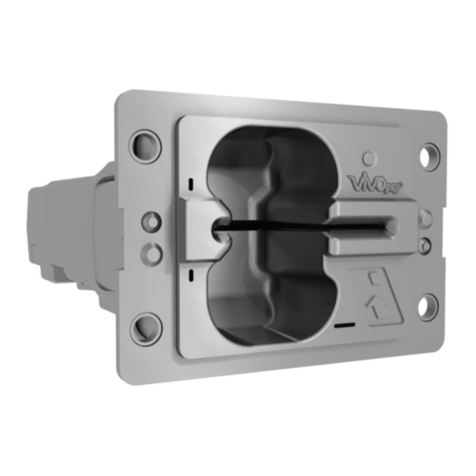
IDTECH
IDTECH ViVOpay VP5300 user manual

HIK VISION
HIK VISION DS-K1107 Series user manual
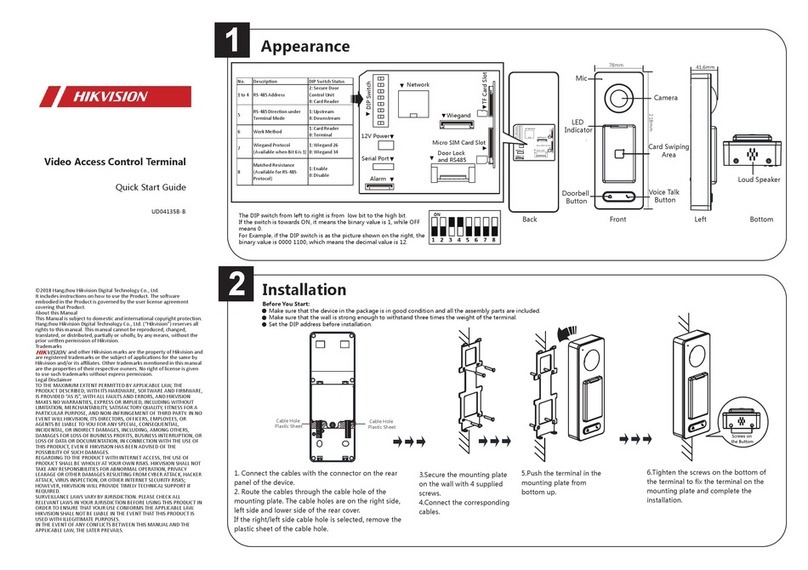
HIK VISION
HIK VISION DS-K1T500 quick start guide
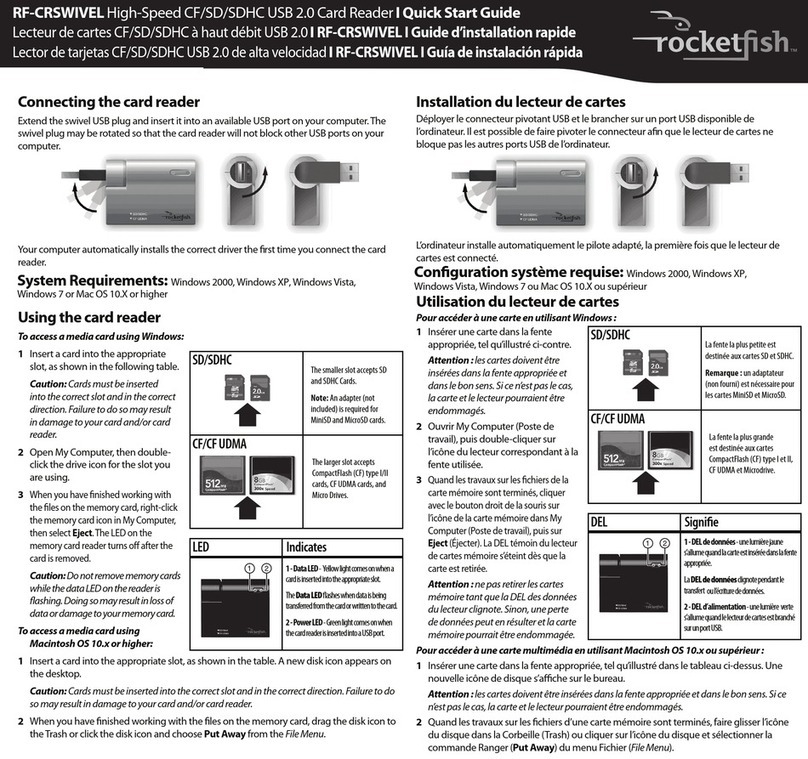
Rocket Fish
Rocket Fish RF-CRSWIVEL quick start guide

Rocket Fish
Rocket Fish RF-CRSWIVEL Guide de l'utilisateur
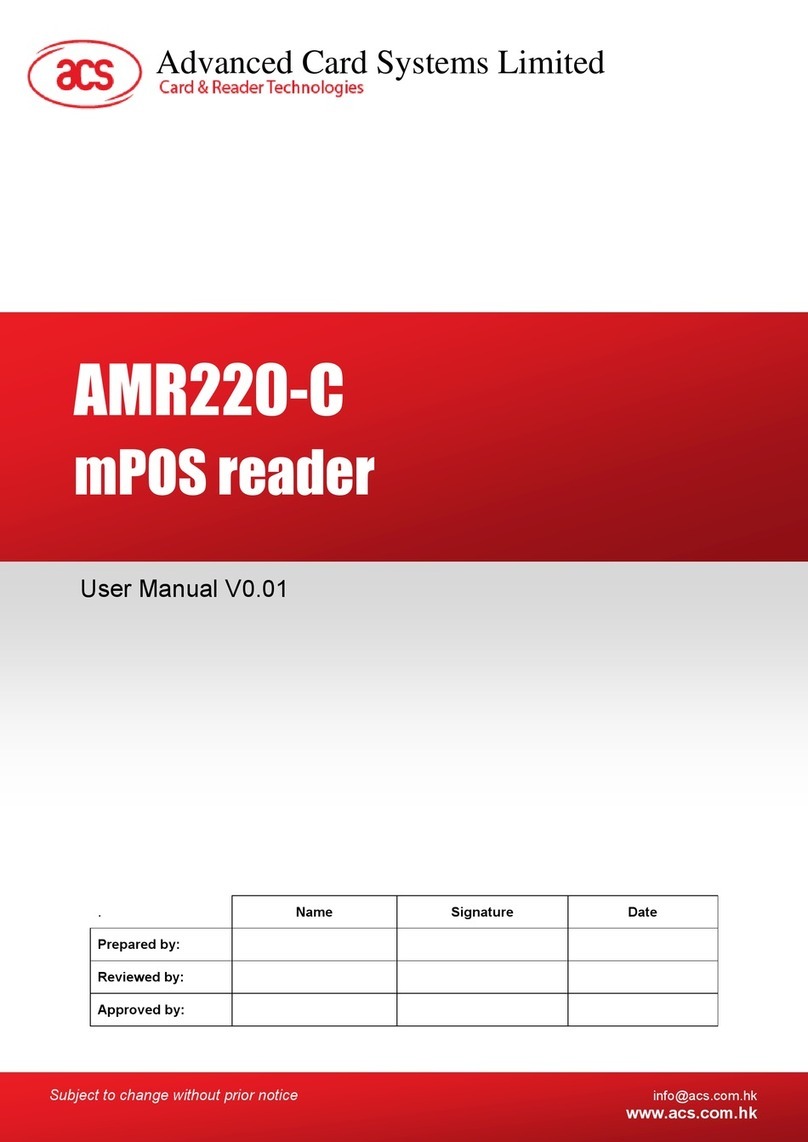
Advanced Card Systems
Advanced Card Systems AMR220-C user manual
